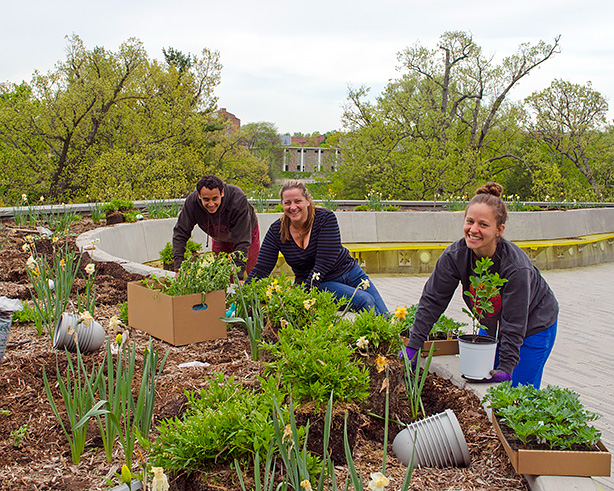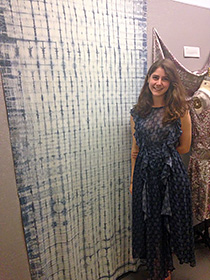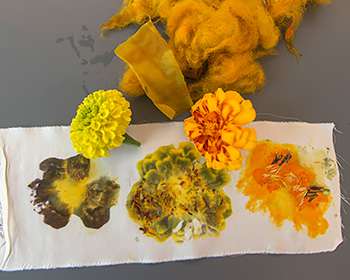
Kamal Maher '18, teaching support specialist Kimberly Phoenix '12 and assistant professor Denise Green '07 tend to the test garden outside the Human Ecology Building, which was planted by Green and students on campus with the help of Human Ecology Facilities Services and Cornell Plantations. Photo: Mark Vorreuter.
Seeds of change: Dye garden promotes sustainable fashion

Denise Green '07, assistant professor in Cornell's Department of Fiber Science & Apparel Design, leads a summer college course, Fashion Design and Visual Thinking (FSAD 1120). Photo: Mark Vorreuter.
Denise Green '07, assistant professor in Cornell's Department of Fiber Science & Apparel Design, was teaching her students about natural dyeing last spring when she noticed scilla siberica, a small perennial with blue bell-shaped blooms, growing on campus, around town and in her front yard. She and her students gathered the plants, put them in glass jars filled with fabric swatches and water, and set them in a sunny spot outside Martha Van Rensselaer Hall. The solar dye bath was the first her class had made with local plant materials.
"After two weeks of incubation, our swatches were a beautiful bright yellow-green," says Green. "To be able to go outside, to harvest right here, was empowering."
Six months later, a new vision is taking root. After a test garden -- planted by Green and students on campus with the help of Human Ecology Facilities Services and Cornell Plantations -- flourished over the summer, Green is now leading a grassroots campaign to permanently install beds between the Human Ecology Building and Martha Van Rensselaer Hall. She envisions plants capable of producing a spectrum of colors, including gypsywort (which makes black dye on wool and silk), wild mustard (yellow), double-flowered yellow flag iris (blackish green), bedstraw (red dye from roots, yellow from flowers), dyer's woad (blue), Japanese indigo (blue), madder root (red), and marigold (yellows and oranges). Funds raised will create new beds and pay for soil, tools and other supplies.

Daniela Cueva, a continuing education student, shows her indigo dyed raw silk using shibori (resist) technique, which was her final project for the course Color and Surface Design of Textiles (FSAD 3250). Photo: Denise Green.
"The new location will be highly visible, making it a great space for educational signage in addition to a wonderful, sunny location for growing," Green says. "We plan to build new beds and cultivate an even greater variety of dye plants."
Green sees working with natural dyes as a way for students to explore the intersection of science, design and sustainability. "It is important to me to make sustainability relevant to students and integrate it into their design practice. The students really, really got into it," Green says. "They were excited to experiment with dyes that have less environmental impact than harsher chemical dyes."
Synthetic dyes have toxic properties that cause serious health and environmental problems throughout the apparel supply chain, from water pollution to human health hazards. In contrast, natural dye plants are not toxic and some grow aggressively without herbicides or fungicides; many are weeds that thrive in roadside ditches. "They don't need much help," Green says.
Still, natural dyes come with complications. Fabrics require a mordant, which is a chemical agent that enables the dye to successfully bond with fiber molecules. Mordants can also be toxic, although less so than synthetic dyes. Natural dyes are also labor-intensive. It can take several days or weeks for the cloth to be scoured, mordanted, dyed and cured. Even then, natural dyes produce a limited palette and unpredictable results. "There are a lot of possibilities with natural dyeing. It's a lot of trial and error," Green says.

Detail from the course Fashion Design and Visual Thinking showing marigolds and, using a technique called "plant printing," how they can be pounded into mordanted fabric and then steam set. Photo: Mark Vorreuter.
Last spring Green's students made natural dye swatch books with squares of cloths, from linen and rayon to cotton, silk, nylon and wool. The results, says Green, were amazing. Lauryn Smith '18, a fine art major, dyed canvases and then painted self-portraits that convey how clothing and fibers work to create and remove intimacy from the human form for an exhibit planned Nov. 16 through Dec. 4 for the Jill Stuart Gallery in the Human Ecology Building.
The most valuable part of the class was watching everyday plants make incredible colors and transformations, Smith says: "You get so involved in the process and you stay with it to the end, smelling the smells, testing pH and measuring temperatures. The result is never guaranteed, but it's usually exciting. It creates a sense of ownership and gratification that synthetic dyes never do."
-- Susan Kelley is a freelance writer.